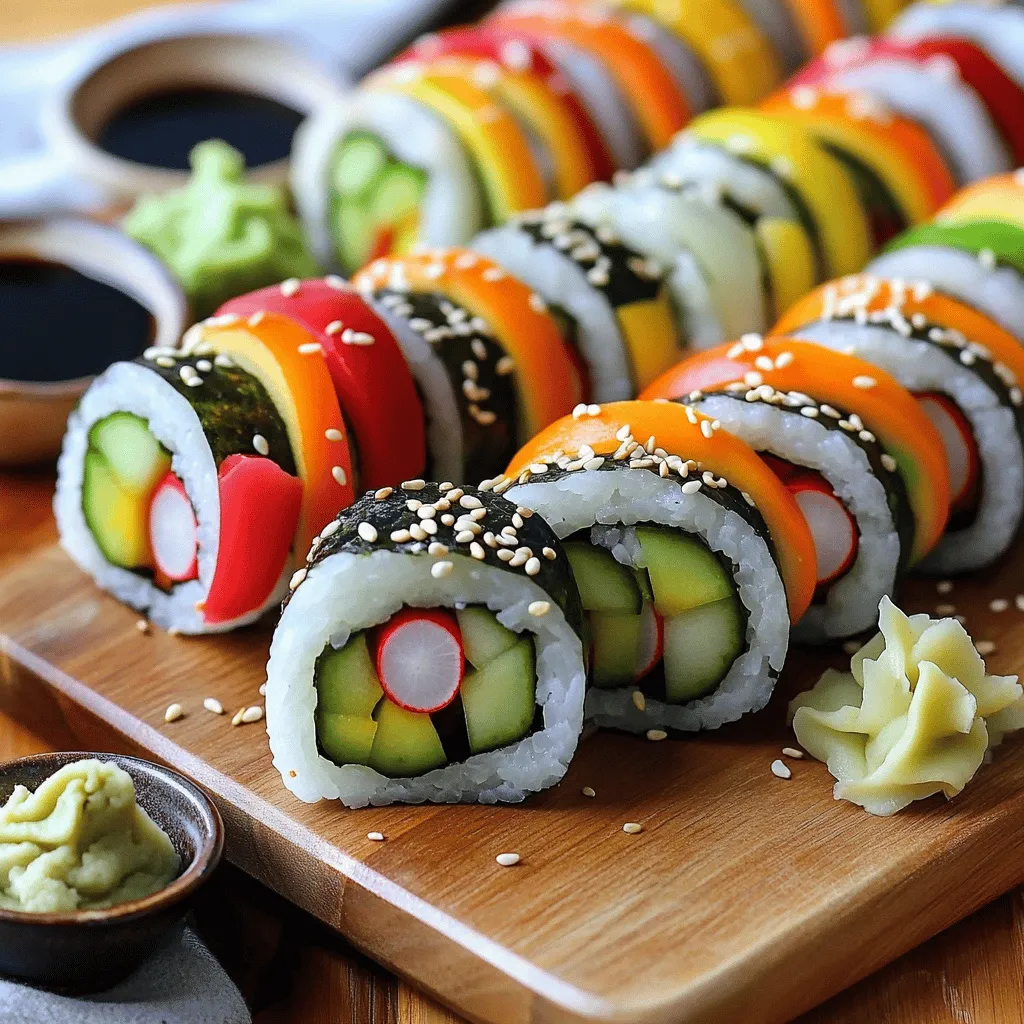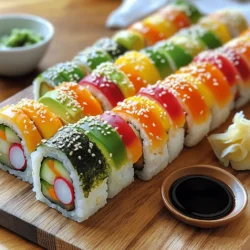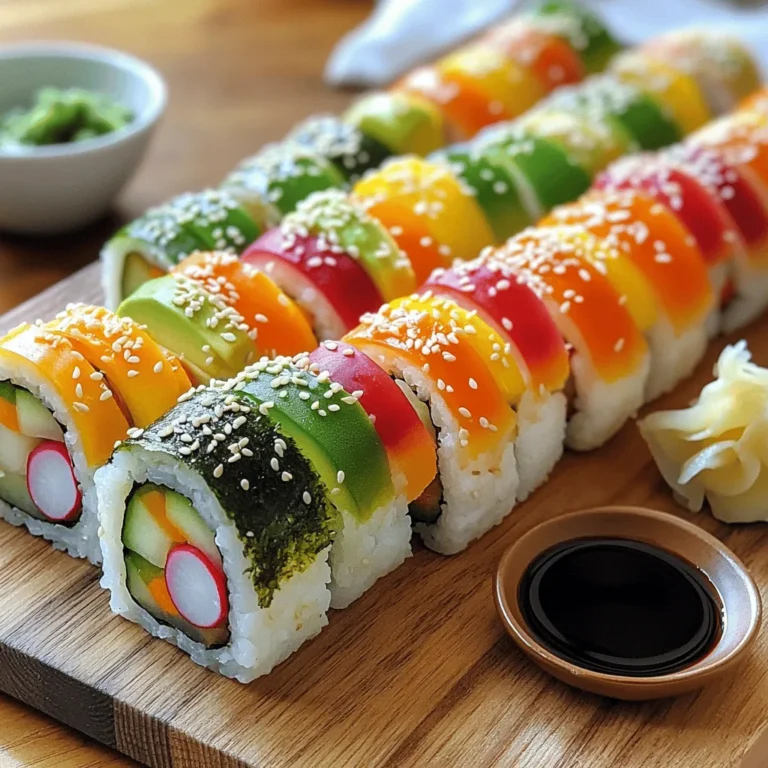Looking to make delicious veggie sushi rolls at home? You’re in the right place! In this simple and healthy recipe guide, I’ll walk you through each step, from selecting the perfect fresh vegetables to assembling and rolling your sushi. You don’t need fancy skills or equipment, just a little passion for good food. Let’s make sushi that’s not only tasty but good for you too!
Ingredients
Main Ingredients for Veggie Sushi Rolls
– 1 cup sushi rice
– 1 ¼ cups water
– 2 tablespoons rice vinegar
– 1 tablespoon sugar
– ½ teaspoon salt
– 4 nori sheets (seaweed)
– 1 small cucumber, julienned
– 1 medium carrot, julienned
– ½ bell pepper, thinly sliced (any color)
– 1 avocado, sliced
– ½ cup radishes, thinly sliced
– Sesame seeds, for garnish
– Soy sauce, for serving
– Wasabi and pickled ginger, for serving (optional)
When I make veggie sushi rolls, I love using fresh ingredients. Sushi rice is key for texture and flavor. You can find it in most grocery stores. Nori sheets hold everything together. They add a nice ocean flavor too.
For the veggies, you can use whatever you like. Cucumber adds a crisp crunch. Carrots give a sweet touch. Bell peppers come in many colors. Avocado makes it creamy and rich. Radishes add a peppery bite.
Recommended Pairings
– Soy sauce for dipping
– Wasabi for heat
– Pickled ginger for freshness
– Edamame for a side dish
– Miso soup for warmth
Dipping sauces can make or break your sushi experience. Soy sauce is a classic choice. It pairs perfectly with sushi rolls. For some heat, add wasabi to your plate. Pickled ginger cleanses your palate.
For sides, you can enjoy edamame. It’s simple and tasty. Miso soup is warm and filling. Both make a great meal with your sushi.
Nutritional Benefits
– Sushi rice is low in fat.
– Fresh veggies provide vitamins.
– Avocado has healthy fats.
– Low calories per roll.
Veggie sushi rolls are not just fun to make; they are healthy too. Sushi rice is low in fat and easy to digest. Fresh vegetables pack vitamins and nutrients. They keep you strong and healthy.
Avocado is a star ingredient. It has healthy fats that are good for your heart. Each roll is low in calories, making it a smart choice for meals.
Step-by-Step Instructions
Preparing the Sushi Rice
– Rinsing the Rice
Rinse the sushi rice under cold water. Do this until the water runs clear. This step gets rid of extra starch. It helps the rice cook well and stay fluffy.
– Cooking the Rice
In a pot, mix the rinsed rice with water. Bring it to a boil over high heat. Once it boils, lower the heat, cover it, and let it simmer for 18-20 minutes. The water should be absorbed by the time it’s done.
Assembling the Sushi Rolls
– Using the Bamboo Mat
Grab a bamboo sushi mat and place it on a clean surface. Cover it with plastic wrap. This makes cleanup easy later.
– Spreading the Rice and Adding Fillings
Put a sheet of nori on the mat, shiny side down. Wet your hands to stop the rice from sticking. Spread about ½ cup of sushi rice on the nori. Leave a 1-inch border at the top. Next, line up cucumber, carrot, bell pepper, avocado, and radishes in the center of the rice.
Rolling and Slicing
– Tips for Rolling
Start at the edge closest to you. Lift the bamboo mat and roll it tightly over the fillings. Keep rolling, tucking the nori as you go.
– Slicing the Sushi Rolls
Once you have a roll, use a sharp knife to slice it into 6-8 pieces. Clean the knife with a damp cloth between cuts. This helps keep the edges neat.
Tips & Tricks
Common Mistakes to Avoid
– Overfilling the Rolls
Keep the fillings simple. If you add too many, the roll won’t hold together. Aim for about three to five ingredients for a balanced bite.
– Not Using Enough Water
Wet your hands and the bamboo mat. This prevents sticking. If you skip this step, the rice may cling to everything, making rolling hard.
Best Practices for Serving
– Presentation Tips
Cut the sushi rolls into even pieces. Arrange them on a clean plate. You can add a sprinkle of sesame seeds for extra flair. Using colorful veggies makes the dish pop.
– How to Cut Sushi Cleanly
Use a sharp knife and wet it to avoid sticking. Make quick, smooth cuts. This helps keep the sushi looking nice and neat.
Tools and Equipment
– Essential Kitchen Tools for Making Sushi
You need a bamboo mat for rolling, a sharp knife for cutting, and a bowl for rinsing rice. These tools make the process easier and more fun.
– Optional Gadgets for Easier Preparation
Consider a rice cooker for perfect rice. A sushi rolling machine can help if you’re new. These tools can save time and make sushi-making enjoyable.

Variations
Different Ingredients
You can change your veggie sushi rolls by using seasonal vegetables. In spring, try asparagus or peas. Summer brings juicy tomatoes and zucchini. Fall is great for roasted sweet potatoes. Winter offers root veggies like carrots and beets. Using fresh, local produce adds flavor and fun.
You can also substitute fresh veggies with proteins. Tofu is a popular choice. Try marinated or grilled tofu for extra taste. Tempeh works well too, providing a nutty flavor. You can even use cooked shrimp or crab if you want a seafood touch.
Flavor Enhancements
To make your rolls even tastier, add spices and sauces. A sprinkle of chili flakes can give a nice kick. You might also try adding a dash of sesame oil for depth. Spicy mayo is a popular choice for a creamy texture.
Using pickled vegetables can add tang to your rolls. Pickled carrots or radishes offer a crunchy bite. They create a contrast with the soft rice and creamy avocado. You can even try pickled ginger for an extra zing.
Themed Sushi Rolls
Themed sushi rolls can spice up your sushi night. Rainbow rolls are colorful and fun. They include a mix of vibrant veggies like avocado, carrots, and bell peppers. Each slice looks like a beautiful rainbow on your plate.
California rolls are another classic. They often have avocado and crab but can easily be made veggie. Just use cucumber and avocado for a fresh twist. These rolls are great for kids or those new to sushi.
Storage Info
Storing Leftover Sushi
Refrigeration Tips
After making your rainbow veggie sushi rolls, store any leftovers in the fridge. Wrap them in plastic wrap or place them in an airtight container. This keeps them fresh. Enjoy them within 24 hours for best flavor.
Freezing Sushi
You can freeze sushi, but it’s not ideal. If you must, wrap each roll tightly in plastic wrap. Place the wrapped rolls in a freezer bag. Use them within a month. Thaw in the fridge before eating.
Reheating Instructions
Best Methods for Quality Preservation
To reheat sushi, use a microwave on low power. Heat for about 10 to 15 seconds. This warms it up without making it rubbery. You can also enjoy sushi cold.
Avoiding Soggy Sushi
Avoid soggy sushi by not using too much moisture when reheating. Keep it wrapped during reheating. Let it sit at room temperature for a few minutes before eating for better texture.
Shelf Life
How Long Sushi Lasts in the Fridge
Sushi lasts about 1 to 2 days in the fridge. After that, it may lose freshness. Always check for signs of spoilage before eating.
Signs of Spoilage
Look for changes in smell, color, or texture. If your sushi smells sour or looks slimy, it’s best to throw it away. Trust your senses to keep safe.
FAQs
Can I use brown rice instead of sushi rice?
Yes, you can use brown rice. Brown rice is healthier and has more fiber. However, it cooks differently. It takes longer to cook and needs more water. Sushi rice is sticky, which helps the rolls stick together. Brown rice may not hold as well. If you prefer brown rice, adjust cooking time and water.
What type of vegetables work best in sushi rolls?
Many vegetables work well in sushi rolls. Here are some great options:
– Cucumber
– Carrot
– Bell pepper
– Avocado
– Radish
You can mix and match any of these. Use what you like best. Try seasonal veggies to keep it fresh.
How do I make my sushi rolls less sticky?
To reduce stickiness, rinse sushi rice well before cooking. Rinsing removes excess starch. This keeps the rice from clumping too much. Also, wet your hands when handling rice. This helps it not stick to your fingers. If rolls still stick, sprinkle a little sesame oil on your hands.
Can I make veggie sushi rolls ahead of time?
Yes, you can prepare some parts ahead of time. Make the sushi rice and veggies in advance. Keep rice in the fridge for up to one day. Roll the sushi just before serving. This keeps it fresh and tasty. Avoid making rolls too far ahead, as they can dry out.
What is the best way to serve sushi?
Serve sushi rolls on a nice plate. You can add a few garnishes like sesame seeds. Offer soy sauce for dipping. Wasabi and pickled ginger add flavor, too. Arrange the rolls nicely for a beautiful display. It makes your meal look gourmet.
Making veggie sushi rolls is fun and rewarding. We covered the key ingredients, how to prepare them, and tips for rolling. You can use fresh vegetables and flavorful sauces to make your sushi tasty. Remember to avoid common mistakes, like overfilling the rolls. Explore different flavors by using seasonal veggies or themed rolls. With these steps, you’ll create delicious sushi at home. Enjoy your sushi-making adventure and impress your friends and family!


